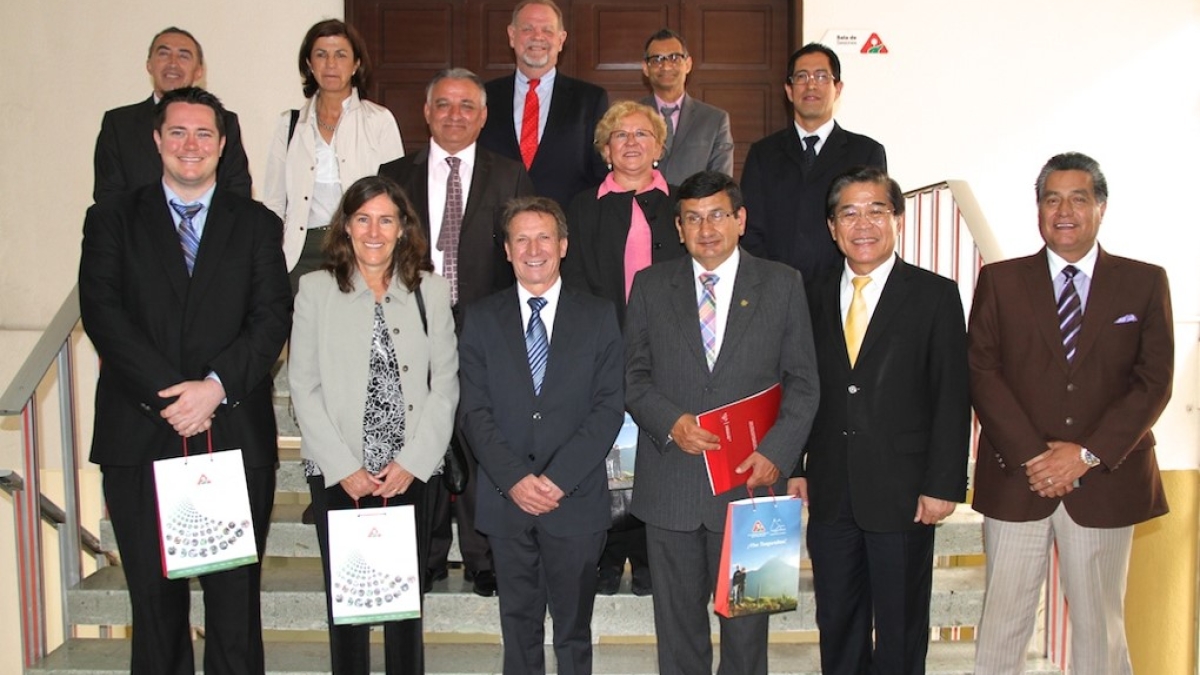Blending innovation, cultural riches to develop a new university

Ideas and methods of designing universities implemented at Arizona State University were prominently featured at a symposium titled “The Future of the University and the University of the Future: A Global Perspective,” held at the Technical University of Ambato (UTA), Ecuador.
Many themes presented echoed ASU President Michael Crow’s emphasis on innovation as a driving force in developing universities that meet the needs of the community.
Higher education institutions in Ecuador are undergoing major reforms, and interest is growing in increasing access and research.
"In a way, it is similar to the motivation behind the New American University," said Mary Jane Parmentier, a senior lecturer with ASU’s Consortium for Science, Policy and Outcomes.
“This was an international conference on the design of higher education, specifically the place of science, technology and innovation, and the role of public policy, in designing universities and programs to meet the needs of society – particularly the society in which each institution is embedded. They wanted people from different countries to bring their perspective on the role of the university and best practices for university design,” added Parmentier, who is also assistant director of ASU's Global Technology and Development Program.
In addition to presenting at the symposium in October, Parmentier served as a liaison for the event from Arizona State University and helped recruit speakers from ASU, most of whom are affiliated with the consortium.
“They wanted me to explain how ASU came to be the New American University,” said Gary Grossman, program director of the Global Technology and Development Program. “Part of what ASU did was restore the public university to its proper place as a place for the people. The questions we asked ourselves are universal, and those were: What is higher education for? Who is it for? What is to be done with it? Those kinds of questions themselves are game-changing.”
Grossman noted Ecuadoreans recognize the value that a deep and rich culture can bring to the design of educational institutions. “They want to be relevant to their circumstances and their national means, which is not going to be exactly like us. What ASU brought was a different perspective than what they are likely to hear from anybody else in North America.”
Several years ago, during a visit to his alma mater, UTA symposium organizer and ASU alumnus Victor Hugo Molina sought out Prasad Boradkar to learn about his research on processes of transdisciplinary innovation. Boradkar is co-director of the Biomimicry Center and director of InnovationSpace at ASU.
“It was incredible to witness what university leaders and government officials are doing in Ecuador,” said Boradkar. “They recognize that education is critical, social impact is critical. They realize that if you want to transform society you need to think of innovation, you need to think of education, you need to think of minimizing the economic divide. They have a powerful understanding of what sort of agendas need to be brought into their thinking to make sure they take Ecuador to the next level.”
Other symposium presenters included Leland Hartwell, Nobel laureate professor in the School of Biological and Health Systems Engineering and chief scientist in the Biodesign Institute's Center for Sustainable Health; Netra Chhetri, associate professor at the Consortium for Science, Policy and Outcomes and the School of Geographical Sciences and Urban Planning; and Cody Paris, an ASU alumnus and now director of social services, Middlesex University in Dubai. Hartwell, Chhetri, Parmentier and Boradkar are all sustainability scientists affiliated with ASU's Julie Ann Wrigley Global Institute of Sustainability.
Hartwell spoke via Skype on the need for all citizens to be educated in scientific areas, noting many compelling methods of accomplishing this at the elementary school level with help from higher education. He discussed the Sustainability Science for Teachers curriculum that he and his team have developed as a way to integrate science and math with issues of sustainability for future teachers in their classrooms.
While acknowledging the importance of Western knowledge systems, in his talk, Chhetri emphasized the need for examining the debate on higher learning from alternate knowledge systems that could offer broader, richer and more diverse perspectives to discourse of science, democracy and globalization. Chhetri further stressed that if universities across Ecuador are to entertain an alternative knowledge paradigm, they should be able to ask non-traditional and context-specific questions. This, for Chhetri, begins with creating the openness of mind to accept these alternatives.
Another member of the ASU contingent, Derrick Anderson, is an assistant professor in the School Of Public Affairs and adviser to the president for innovation. Anderson said he approached the conference from two perspectives: “as an academic who is interested in the design of institutions, and also as a design agent or institutional architect in the Office of the President. I was expecting to see higher education institutions aspiring to be like Ivy League institutions.
“The surprising thing was that there were so many robust discussions of public value and social responsibility," Anderson said. "They were interested in thinking about meaningful institutional design – not just in education but also in research – I thought that was really interesting. I think we brought a set of frameworks for them to contextualize their diverse ways of thinking, and we were able to help them discipline and systematize those ideas.”
Boradkar expressed his hope to find “mechanisms by which we can share ideas. We can learn from them; they can learn from us. There is as much for us to learn from Ecuador as there is for us to share with them. We are seeking reciprocity of knowledge – a mutually beneficial relationship.”

